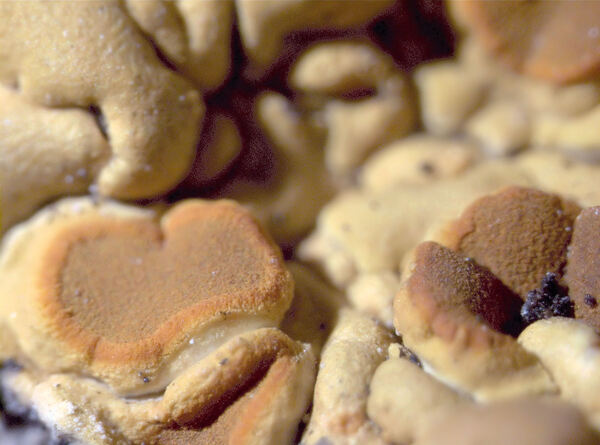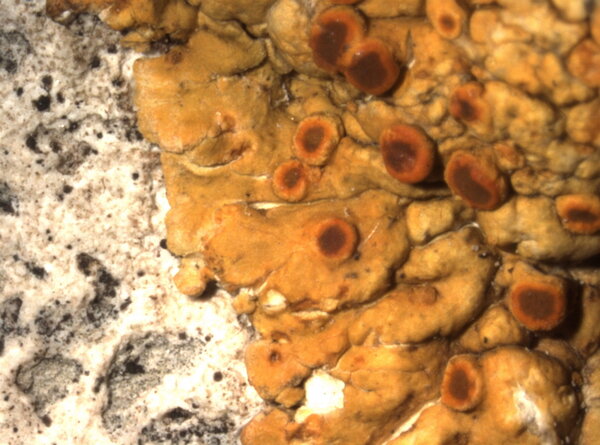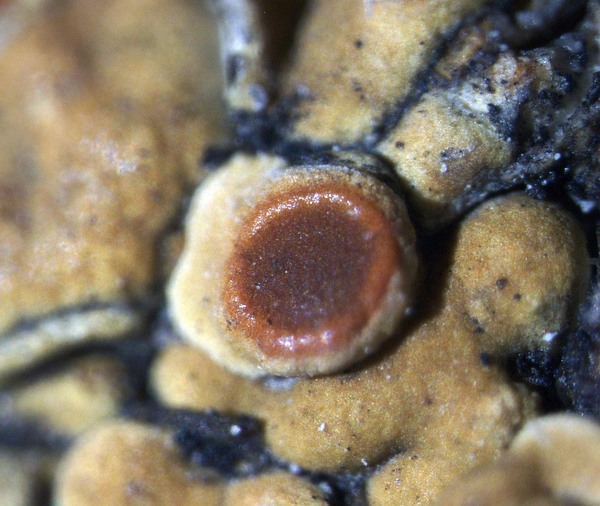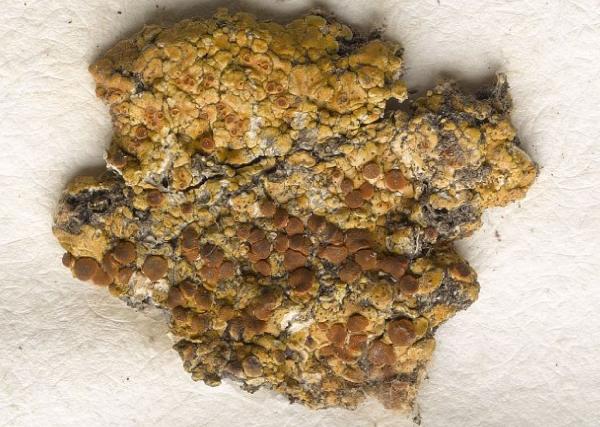Gyalolechia aurea (Schaer.) A. Massal.
Ric. Auton. Lich. Crost.: 17, 1852. Basionym: Lecidea aurea Schaer. - Naturwiss. Anz., 2: 11, 1819.
Synonyms: Caloplaca aurea (Schaer.) Th. Fr.; Candelariopsis aurea (Schaer.) Szatala; Thalloidima aureum (Schaer.) Müll. Arg.
Distribution: N - Frl, Ven (Nascimbene & Caniglia 2003c), TAA (Nascimbene & al. 2022), Lomb, VA (Piervittori & Isocrono 1999), Emil (Fariselli & al. 2020). C - Abr (Nimis & Tretiach 1999, Gheza & al. 2021).
Description: Thallus crustose, episubstratic, areolate, ochraceous yellow to bright orange-yellow, epruinose, thick, forming irregular patches to 4(-6) cm, anchored to thin layers of soil in rock fissures by rhizine-like bundles of hyphae. Areoles 1-2(-3) mm broad, flattened to convex, smooth, contiguous, the marginal ones often elongate, up to 2-3 mm long. Apothecia frequent, zeorine, sessile, slightly constricted at base, 0.5-1.5(-2) mm across, with an orange-brown to olive-brown, flat to slightly convex, rugose disc, and a thick, bright orange to cinnamon-red margin, soon dividing into a paler, thinner proper margin, and a thicker, but often finally excluded thalline margin. Epithecium orange, with a K+ purple-red, granular epipsamma; hymenium colourless, 80-100 µm high; paraphyses mostly simple, not anastomosing; hypothecium colourless. Asci 8-spored, clavate, functionally unitunicate, apically thickened with a broad internal beak, the inner part of apex and external cap I+ blue, Teloschistes-type. Ascospores 2-celled with an open, short (<2 µm) equatorial thickening, hyaline, narrowly ellipsoid to fusiform, constricted in the middle and with pointed ends, 12-20(-25) x 4-7 µm. Pycnidia orange-yellow, immersed. Conidia ellipsoid, 1-celled. Photobiont chlorococcoid. Spot tests: thallus and apothecia K+ red, C-, KC-, P-. Chemistry: fragilin dominant, with smaller amounts of emodin and parietin; physcion present in the apothecia. Note: a species of the mountains of Central and southern Europe, found on plant debris and mosses in fissures and cracks of calcareous rocks and dolomite, with optimum above treeline; widespread but not common in the Alps, and also occurring on the highest peaks of the central Apennines (the record from Abruzzo is the southernmost in Europe).
Growth form: Crustose
Substrata: soil, terricolous mosses, and plant debris
Photobiont: green algae other than Trentepohlia
Reproductive strategy: mainly sexual
Commonnes-rarity: (info)
Alpine belt: common
Subalpine belt: rather rare
Oromediterranean belt: absent
Montane belt: absent
Submediterranean belt: absent
Padanian area: absent
Humid submediterranean belt: absent
Humid mediterranean belt: absent
Dry mediterranean belt: absent
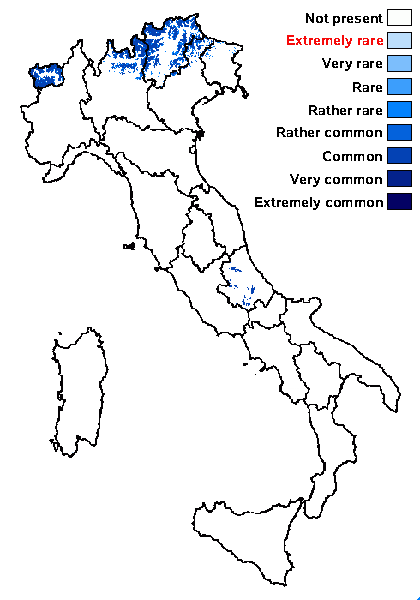
Predictive model
Herbarium samples
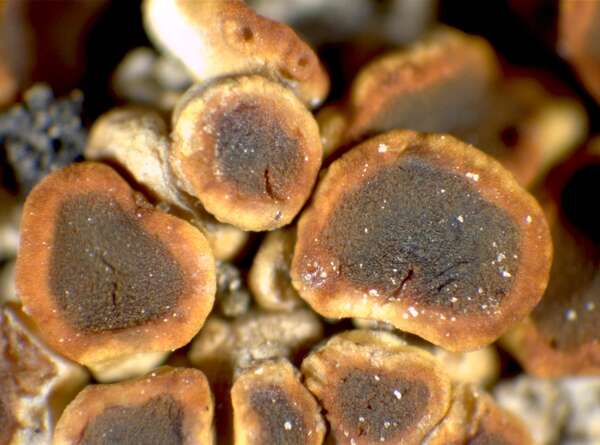

P.L. Nimis; Owner: Department of Life Sciences, University of Trieste
Herbarium: TSB (15375)
2001/12/18
old apothecia
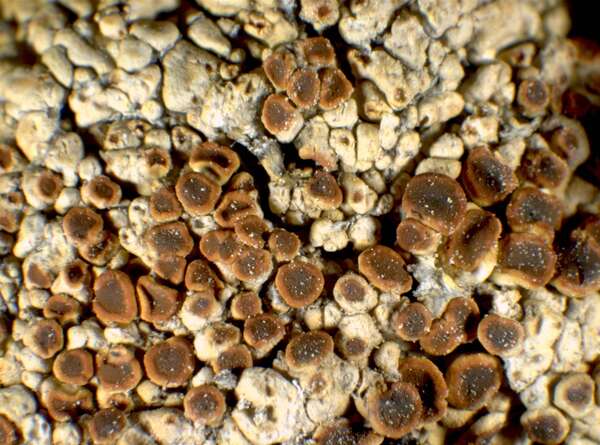

P.L. Nimis; Owner: Department of Life Sciences, University of Trieste
Herbarium: TSB (15375)
2001/12/18
Growth form: Crustose
Substrata: soil, terricolous mosses, and plant debris
Photobiont: green algae other than Trentepohlia
Reproductive strategy: mainly sexual
Commonnes-rarity: (info)
Alpine belt: common
Subalpine belt: rather rare
Oromediterranean belt: absent
Montane belt: absent
Submediterranean belt: absent
Padanian area: absent
Humid submediterranean belt: absent
Humid mediterranean belt: absent
Dry mediterranean belt: absent

Predictive model
| Herbarium samples |


P.L. Nimis; Owner: Department of Life Sciences, University of Trieste
Herbarium: TSB (15375)
2001/12/18
old apothecia


 INDEX FUNGORUM
INDEX FUNGORUM
 GBIF
GBIF
 DOLICHENS
DOLICHENS




